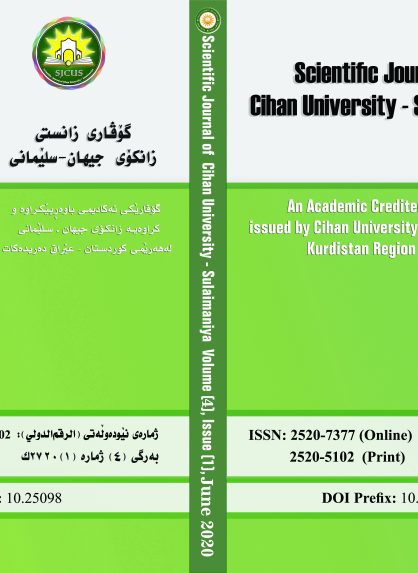| published |
| DOI
http://dx.doi.org/10.25098/4.1.25 |
A Componential Analysis of Kinship Terms in Central Kurdish
Twana Saadi Hamid1, Bestoon Hassan Ahmed2
English Department, College of Languages, University of Slemani, Slemani, Iraq1
Kurdish Department, College of Basic Education, University of Slemani, Slemani, Iraq2
Email: [email protected]1
Received : 20-11-2019 Revised:2-3-2020
Accepted : 7-5-2020 Published :30-6-2020
Abstract:
This paper addresses the semantic field of kinship terms in Central Kurdish (CK henceforth). The study uses data of Basic (blood) relations and Non-basic (marriage) relations. It tries to test whether CK kinship terms can be explained through the use of semantic features. It also tries to find out what kind of features are employed to compare and contrast different dimensions of kinship terms. Kinship terms in other varieties of Kurdish such as Kalhori and Hawrami have been studied. However, to the best of our knowledge, no study has looked into the kinship terms in the Central dialect of Kurdish. Moreover, no study has combined and compared both basic and non-basic kinship terms. This study found that kinship terms in CK lend themselves to componential analysis in a clear way. That is, semantic features can explain the relation between both basic and non-basic kinship terms. The semantic features that are employed for depicting basic kinship terms are Generation, Sex, Lineality and Direction of Kinship. The same four features are used for non-basic kinship terms with another feature known as New Marriage. Another finding of the study is that basic kinship terms, in contrast to non-basic kinship terms, can be used as terms of address.
References:
Bistoon, A., A. Gheitury and K. Kazzazi. 2013. ‘Semantics of Hawrami Kinship Terms’. International Journal of humanities. 20 (4): (1-21).
Boas, F. 1919. ‘Kinship Terms of Kutenai Indians’. American Anthropologist, 21(1): (98–101).
Cruse, A. 2006. A Glossary of Semantics and Pragmatics. Edinburgh: Edinburgh University Press.
Crystal, D. 2003. The Cambridge encyclopedia of the English language. Cambridge: Cambridge University Press.
Durbin, M. A. 1972. ‘Linguistic Models in Anthropology’. Annual Review of Anthropology. 1: 388.
Gheitury, A. , H. Yasami, K. Kazzazi. 2010. ‘A Note on Kalhori kinship terms’. Iranian Studies.. 43 (4): 533-547.
Jackendoff, R. 1987. Consciousness and the computational mind. Cambridge: The MIT Press.
Katz, J. J., and J. A. Fodor. 1963. ‘The structure of a semantic theory’. Language. 39(2): (170-210).
Kuznecov, A. 2009. ‘On the Typology of the Semantic field of Kinship terms’. Linguistics. 12(125): 5-14.
Lyons, J. 1977. Semantics (Vol. 2). Cambridge: Cambridge university press.
Lyons, J. 1995. Linguistic semantics: An introduction. Cambridge: Cambridge University Press.
Matthews, P. H. 2000. Oxford Concise Dictionary of Linguistics. Shanghai: Shanghai Foreign Language Education Press.
Murray, L. 2006. ‘Experimental-Formal Analysis of Kinship’. Ethnology 45(4): 305-330.
Palmer, F. R. 1976. Semantics. Cambridge: Cambridge university Press.
Pinker, S. and Levin, B. 1992. Lexical and conceptual semantics. Oxford: Blackwell publishing.
Prasithrathsint, A. 2001. ‘A componential analysis of kinship terms in Thai’. Essays in Tai Linguistics. 261-275.
Saeed, J. I. 1997. Semantics. Oxford: Blackwell Publishing.
Sharafkandi, Abdul-rahman. 1990. Hambana Borina.Tehran: Surush Publications.
Wallace, A. and J. Atkins. 1960. ‘The Meaning of Kinship Terms’. American Anthropologist, 62(1): (58-80).



